Competitor analysis is a cornerstone of growing any business. Without understanding what your competitors are doing to drive traffic and users to their site who ultimately purchase their products/services, you will struggle to gain traction.
Thankfully, in the last 5-7 years many tools have come onto the market that can provide us the data we need to conduct research into our competitors to learn what they are doing online. In this specific article we are going to walk you through competitor analysis using SEMrush, though you can also do varying degrees of it with other industry-accepted tools like Moz and Ahrefs.
Note: Credo is a SEMrush affiliate, and because of that they’re offering you a FREE 14 day trial when you use our exclusive link.
So let’s dig into how to use SEMrush to do competitor research using their keyword/ranking database, their keyword and backlink gap tools, and projects.
As we explained in our guide to keyword research using SEMrush, SEMrush has a database of over 5.8 billion keywords worldwide, with 780 million keywords alone in the United States. They also have hundreds of millions in many countries and tens of millions in others (full list):
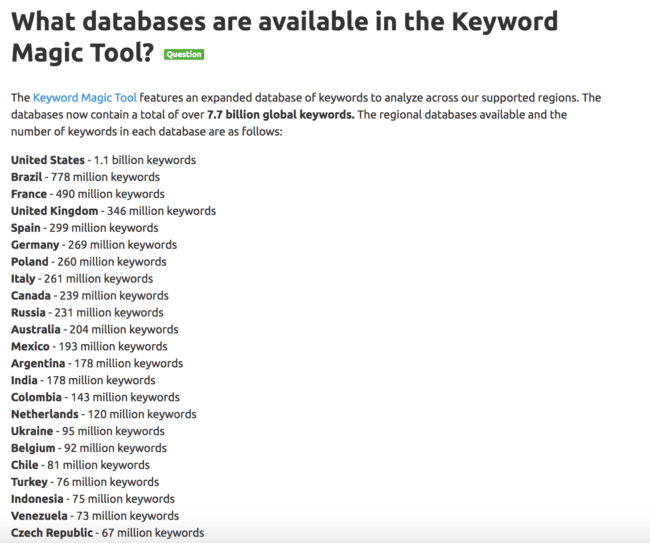
You can leverage this data, no matter what country you are in, to look up your competitors to see:
While SEMrush is just a tool and does not do the work for you to capitalize on the knowledge you gain, their data can be used to grow your business should you build strategies off of the knowledge obtained.
The simplest way to use SEMrush to do competitor analysis is first to identify your competitors.
Hopefully you know who your main business competitors are. They’re the people selling the same services as you that people see as direct competitors to you. If your potential customer does not sign a deal with you or buy your product, this is why they are likely buying from.
You also have search results competitors. Your direct business competitors may do a bad job of SEO and thus don’t rank alongside you, or maybe they rank better than you and that’s worth knowing.
To identify your search competitors, go to your SEMrush dashboard and enter your domain:

When you land on the overview page for your domain, scroll down to the Main Organic Competitors section to see the top 5 in common with the keywords for which you already rank:

Click on that title to be taken to the full list of your search competitors based on the keywords you already rank for:

From here, I recommend manually verifying the sites that are most relevant to your business that are basically your direct competitors. In the above example, looking at Amazon will just give me a TON of data that is not useful to my business, but BackCountry, OutdoorGearLab, and Switchback Travel are all sites that I should look at more closely since they are outdoors industry sites and write gear reviews like Single Geared:

From here click the competitor’s SE Keywords link to be taken to a view like this:
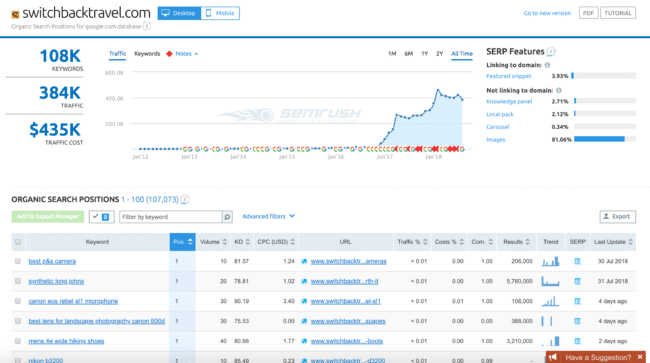
From here, you can do one of two things:
Do this across all of your competitors and you’ll end up with a lot of data to analyze. What you’ll specifically look for is:
All of the data in the world doesn’t do you much good if you don’t turn it into insights, but when you do and can prioritize based on opportunity then you can do very well.
What if you’re investigating a new vertical or haven’t done any SEO on your site and thus you don’t rank for anything? The above strategy won’t do much for you.
We need to identify competitors based on keyword. Here’s how you do that in SEMrush.
Let’s say I run an outdoor gear reviews website (which I do as a side project). But, let’s also say that I haven’t put much time into it and therefore I’m not going to have a great understanding of the major players in my space.
Instead of typing in a website like before, I am going to enter a specific keyword that I might want to rank for, in this example a review of a climbing shoe:
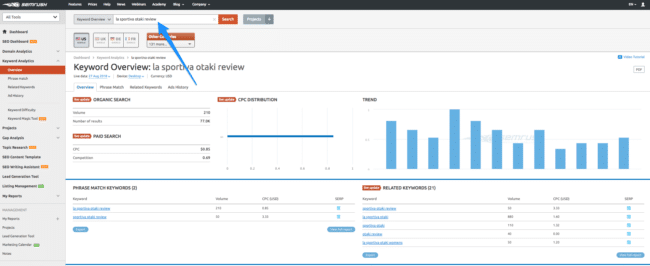
When I scroll down the page, SEMrush shows me all of the sites ranking for that keyword:
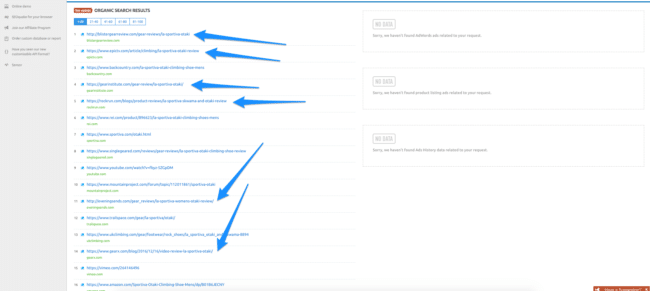
Repeat this a few times and you will start seeing the same sites time and time again. Through following this process with 5-10 keywords, I know that the big players in the climbing shoe review niche are:
I can then take all of these competitors and plug them into the process outlined at the beginning of this article.
One of my favorite tools within the SEMrush toolkit is their Keyword Gap Analysis tool found near the bottom on the left side of the dashboard:
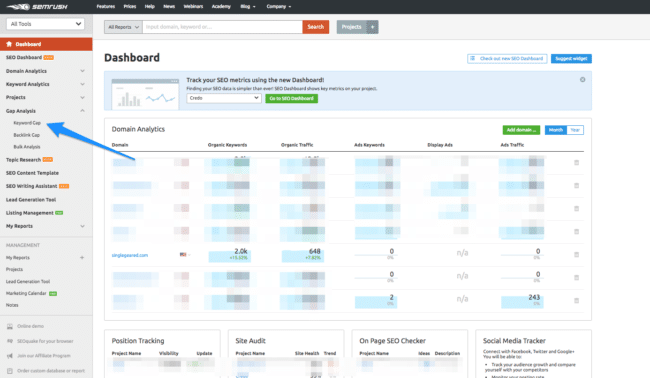
Using this tool, you can take the 3-4 competitors you have discovered using the above strategies and begin to understand how much they overlap and where your opportunities are to create content to either compete or outflank them by targeting keywords that they are not currently.
Remember: the purpose of competitor research is always to create an actionable strategy that you can implement to beat them.
To use the Keyword Gap tool, enter in your domain and up to four of your competitors (or, if you do not have a site yet then enter five competitors!).
In this initial view, you will be shown how well your competitors rank for the keywords that your site ranks for:

This can be quite useful, but what about when your site is by far the smallest in the group and you are looking to expand your keyword list based on what your biggest competitors are ranking for? While you may not be able to rank for these terms yet (though you may depending on how you think they are ranking), knowing what they are writing about and competing for can help you plan your own site information architecture.
To do this, put your largest competitor’s site in the first column and then on down from there. You’ll get a report like this that has all of your competitors and what they rank for.
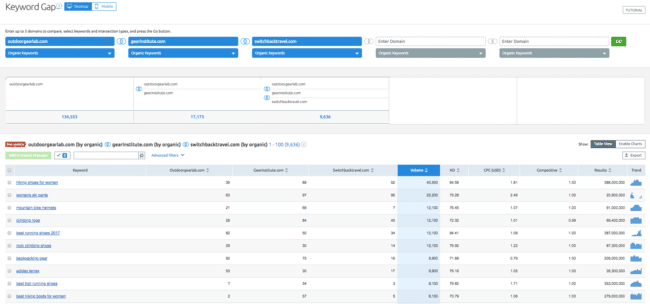
If you’re interested in what the first two are ranking for in common, click the number underneath that comparison to view just those keywords:
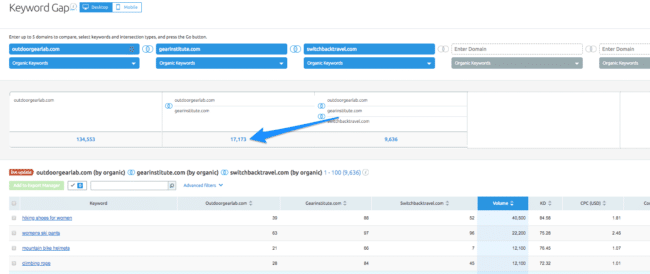
If you then want to put your own rankings against that, download your own site’s keywords and rankings. Then in Excel, take the download of your competitors and add a column for your own site. Then use a VLOOKUP to put your own rankings against the keywords.
By doing this, you will quickly identify the keywords that your competitors have targeted that you have not. There is your list to begin prioritizing.
When you’re doing SEO competitor research, you also need to learn what your competitors are doing to rank. You can study their landing pages and their keywords, but if they’re ranking then they probably have good links from other sites pointing in to their site. In SEO these are called “links” or “backlinks”, and those terms are used interchangeably.
SEMrush’s Backlink Gap Analysis tool lets you see what links your competitors have, who has links from that site, and you can quickly identify sites where you might also target getting links.
Find the Backlink Gap tool in the left sidebar right under Keyword Gap:
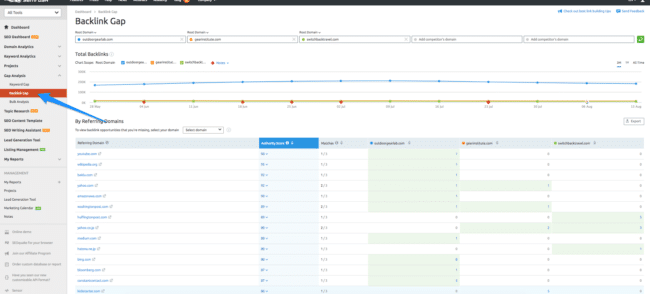
Enter your competitors and your own site into the boxes along the top so that you can identify where your competitors have links that you do not:
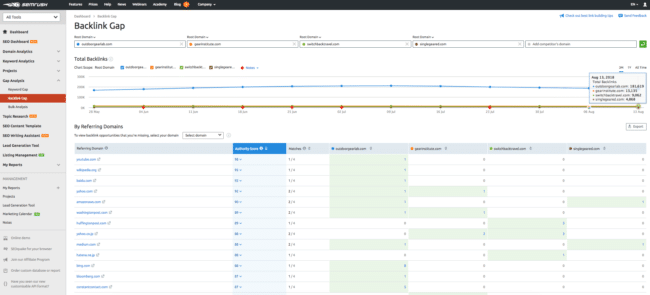
Of course, this just gives you a list of websites linking to competitors (and your site) but it does not tell you the strategies they have used to acquire those links.
To identify their tactics, right click and open in a new tab the sites where they have the most links:
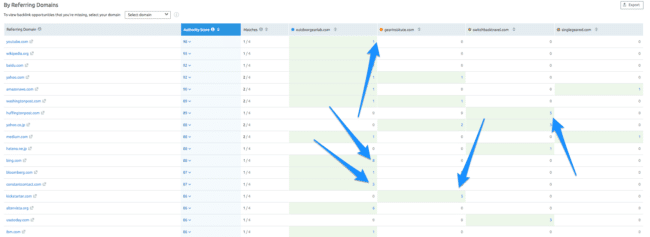
You’ll see a page like this:
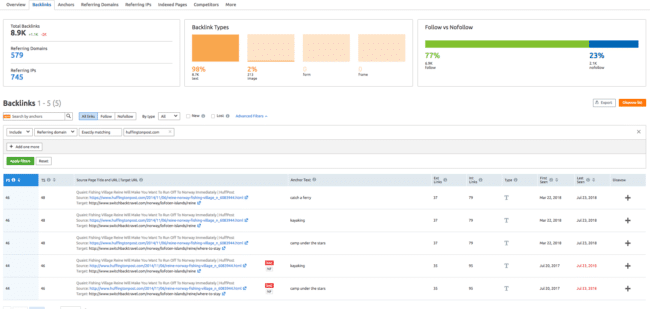
Click on the URLs and find the link(s) contained within those pages to start to identify the strategies each competitor has been employing.
For example, I know that:
With just this knowledge alone, I can understand how they are beating me (because I haven’t done any focused link building for my site). I can also see the opportunities for building links and can lean on my own strengths to increase the exposure of my site.
Going back to the overview competitor page, I recommend downloading as much of the data as you can and prioritizing the stronger sites while also recognizing that those take longer to get live. I like to take the list of sites and add a column where I determine the type of link I could get (forum, guest post, media mention, etc) and put together a strategy from there.
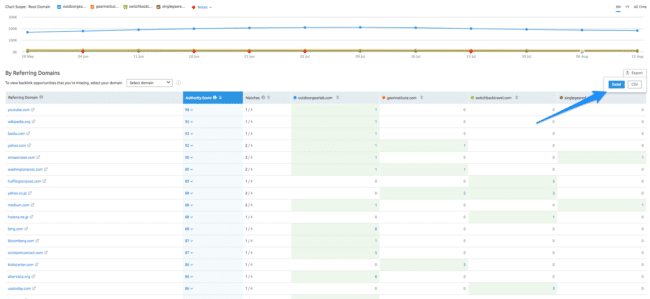
There you are, competitor research within SEMrush. With their database size and the myriad of tools they have built over the last few years, you can gain incredible insight into what your competitors are doing and what you can do to catch up or stay ahead of the market.
Note: Credo is a SEMrush affiliate. If you click to SEMrush using our link to take the free 714day trial and then sign up for a paid account, we may be compensated monetarily. Credo pays for our own SEMrush account and always have.
This page last updated on July 8, 2020 by John Doherty
Download guide in PDF format
Oops! We could not locate your form.
Drive results for your marketing needs with the Credo network. Get started today (it's free and there is no obligation)!